
Digital asset management (DAM) centralizes and organizes valuable digital files—images, videos, documents and more—so teams can find, share and reuse them efficiently. A DAM system provides metadata, version control, permissions and workflows that streamline collaboration, protect brand integrity and improve return on content investments.
Over the past decade, businesses have undergone a dramatic shift in how they create, store and distribute content. Traditional marketing materials such as print advertisements and television spots have given way to digital campaigns that leverage images, videos, audio clips, animations, documents, presentations and interactive experiences across websites, social media and mobile applications. The explosion of digital media has created vast libraries of files that must be managed carefully to ensure efficiency, compliance and brand consistency. Without a structured approach, teams waste countless hours hunting for files, risk using outdated assets and struggle to maintain control over usage rights and approvals.
Digital asset management (DAM) has emerged as a critical discipline that addresses these challenges. A DAM platform provides a centralized repository where organizations store, organize, manage and distribute their digital assets. It supports workflows that govern the asset lifecycle from creation through usage and archival, and it integrates with other systems to automate the flow of content. This article delves into the essence of digital asset management, starting with the fundamental question, “What is a digital asset?” We will explore what a DAM solution does, outline the benefits of implementing one, identify who uses DAM and why, and provide practical guidance on how to choose and implement the right system for your organization. Along the way, we will highlight industry use cases, discuss best practices for adoption and look at emerging trends that are shaping the future of DAM.
Understanding digital asset management is essential for any organization that produces or leverages digital content. Whether you are a marketer seeking to streamline campaign production, a designer collaborating on brand materials, a sales professional in need of up-to-date collateral or an IT manager responsible for organizing media libraries, a robust DAM strategy can transform your workflows. By the end of this comprehensive guide, you will have a clear grasp of the concepts, benefits and practical considerations involved in digital asset management, empowering you to make informed decisions and unlock the full potential of your digital assets.
A digital asset is any form of content or data that exists in a digital format and holds value for an individual or organization. It is a broad term encompassing a wide range of file types, each of which plays a role in communication, marketing, sales, product development, training and operations. To understand the scope of digital asset management, it is essential to recognize the diversity and importance of digital assets in today’s organizations.

Digital assets include any type of media or content stored electronically. Common examples are:
The value of a digital asset lies in its ability to convey information, evoke emotions, build brand recognition, educate audiences, drive sales or support internal processes. As such, organizations invest significant time, effort and resources into creating and acquiring digital assets.
To qualify as a digital asset, a file typically exhibits several characteristics:
Recognizing these characteristics is important because digital asset management systems must handle them effectively to maximize the asset’s value and ensure it is used appropriately.

The variety of digital assets used by businesses is vast. A retail organization may manage product photography, promotional videos, packaging designs and social media graphics. A manufacturing company might store CAD drawings, product documentation and compliance certificates. An educational institution needs lecture recordings, course materials and marketing brochures. Non-profit organizations rely on donor outreach emails, event photos and volunteer training materials. Across sectors, digital assets are the building blocks of communication, marketing, sales, training, compliance and customer experience.
In summary, digital assets are the digital files that carry the messages, visuals and information that organizations use to operate and thrive in the digital age. They must be protected, organized and leveraged to their full potential, which brings us to the discipline of digital asset management.
Digital asset management refers to the processes and technologies used to organize, store, manage, retrieve, share, distribute and ultimately archive an organization’s digital assets. It involves both a strategic approach—governance, policies, workflows, roles and responsibilities—and a technical solution—software that provides the infrastructure to manage assets effectively. Together, these elements ensure that digital assets are accessible, secure and controlled throughout their lifecycle.
While the specific features of DAM platforms vary, they generally provide several core functions:
In essence, digital asset management combines organizational processes with specialized software to bring order and efficiency to the management of digital media. By implementing a DAM, organizations gain control over their assets, streamline workflows and empower teams to work more collaboratively.
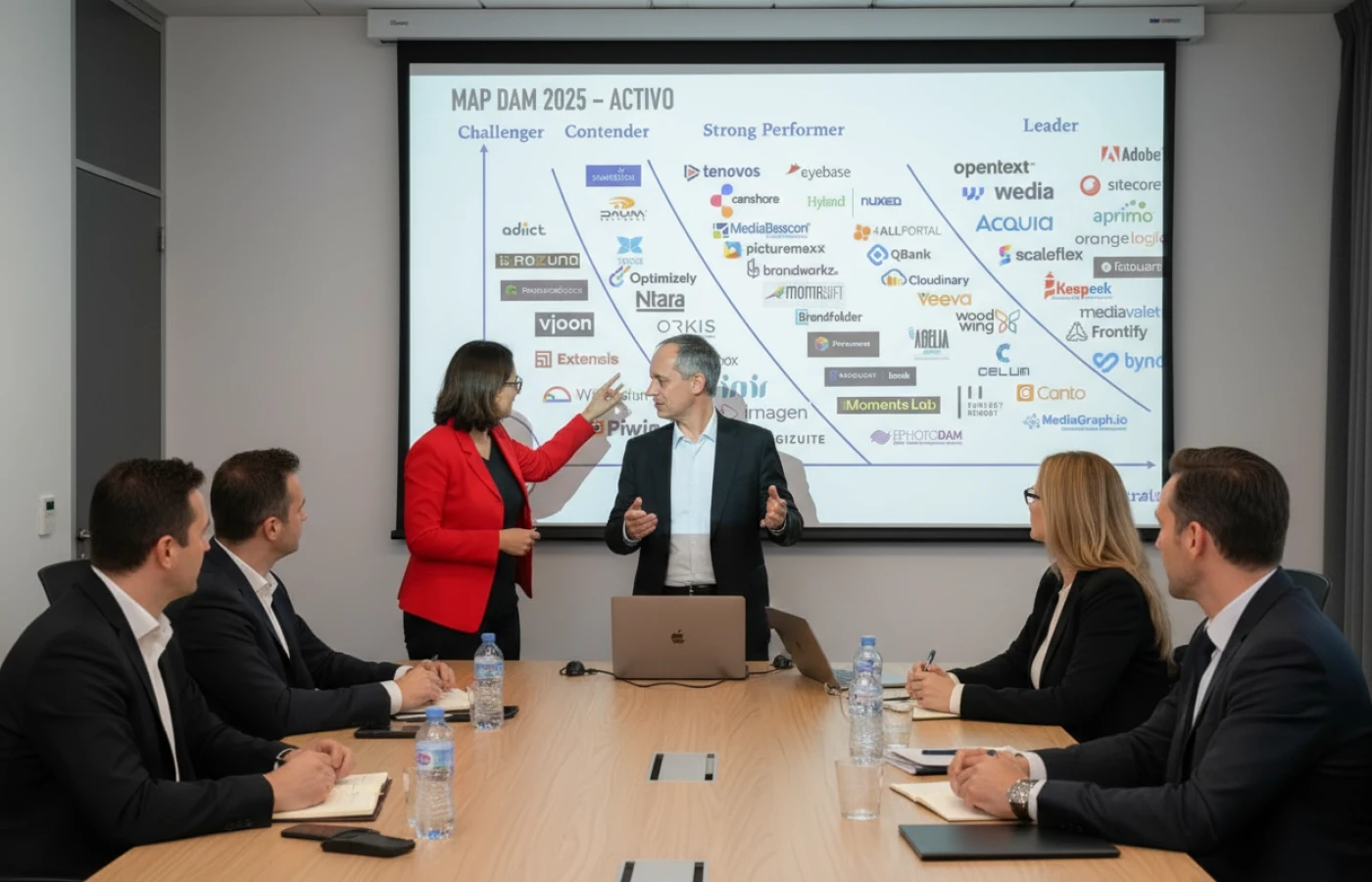
A digital asset management solution is more than just a storage system; it is an active platform that supports the entire lifecycle of digital assets, from creation through archiving. Understanding what a DAM solution does involves looking at how it handles each stage of the asset lifecycle and how it integrates with other tools to deliver value across the organization.
The first step in the asset lifecycle is ingestion—importing files into the DAM. A DAM solution simplifies this process by supporting bulk uploads, drag-and-drop functionality and automated import from other systems. During ingestion, the DAM can automatically extract metadata from files (e.g., EXIF data from images) and apply predefined metadata templates based on file type, project or department. Some DAM platforms also integrate with creative tools like Adobe Photoshop, Illustrator and Premiere Pro, allowing designers to save files directly into the DAM without leaving their creative environment.
Certain DAM solutions include built-in editing and asset creation tools. For example, a photographer might adjust brightness or crop a photo within the DAM, or a video editor might trim and compile clips. While specialized editing tools remain essential for advanced work, these basic editing capabilities streamline simple adjustments, saving time and avoiding the need to download files for minor changes.
Once assets are imported, the DAM assigns metadata. Metadata can be automatically extracted or manually entered by users, using drop-down menus, text fields, checkboxes or auto-suggestions. A well-designed DAM allows administrators to define metadata schemas and controlled vocabularies that align with the organization’s taxonomy. This standardization ensures consistency across assets and makes search more effective. For example, an organization might create metadata fields like “Campaign,” “Product Line,” “License Expiry Date,” “Region” and “Usage Rights,” each with a predefined list of values.
Some DAM solutions use artificial intelligence (AI) and machine learning to automate metadata tagging. Image recognition algorithms can identify objects, people, locations or product SKUs in photos and apply relevant tags. Natural language processing can analyze the content of documents or transcripts of videos and generate keywords. AI-generated metadata augments manual tagging, improves search and lowers the effort required to maintain an accurate library.
Digital assets are rarely created by a single person in isolation; they often involve collaboration among designers, marketers, product managers, legal teams and executives. A DAM solution provides tools for collaborative review and approval. Stakeholders can view assets, leave comments, annotate specific areas, suggest changes and approve or reject files. Version control ensures that feedback is applied to the correct version and that multiple iterations are tracked. Notifications and task assignments keep projects moving forward, preventing delays.
Workflows can be customized to reflect organizational processes. For example, new product photos might automatically be routed to a marketing manager for metadata review, then to a brand manager for approval before being published on the website. By automating these steps, a DAM ensures that assets pass through the appropriate stages, reducing manual follow-up and maintaining consistency.
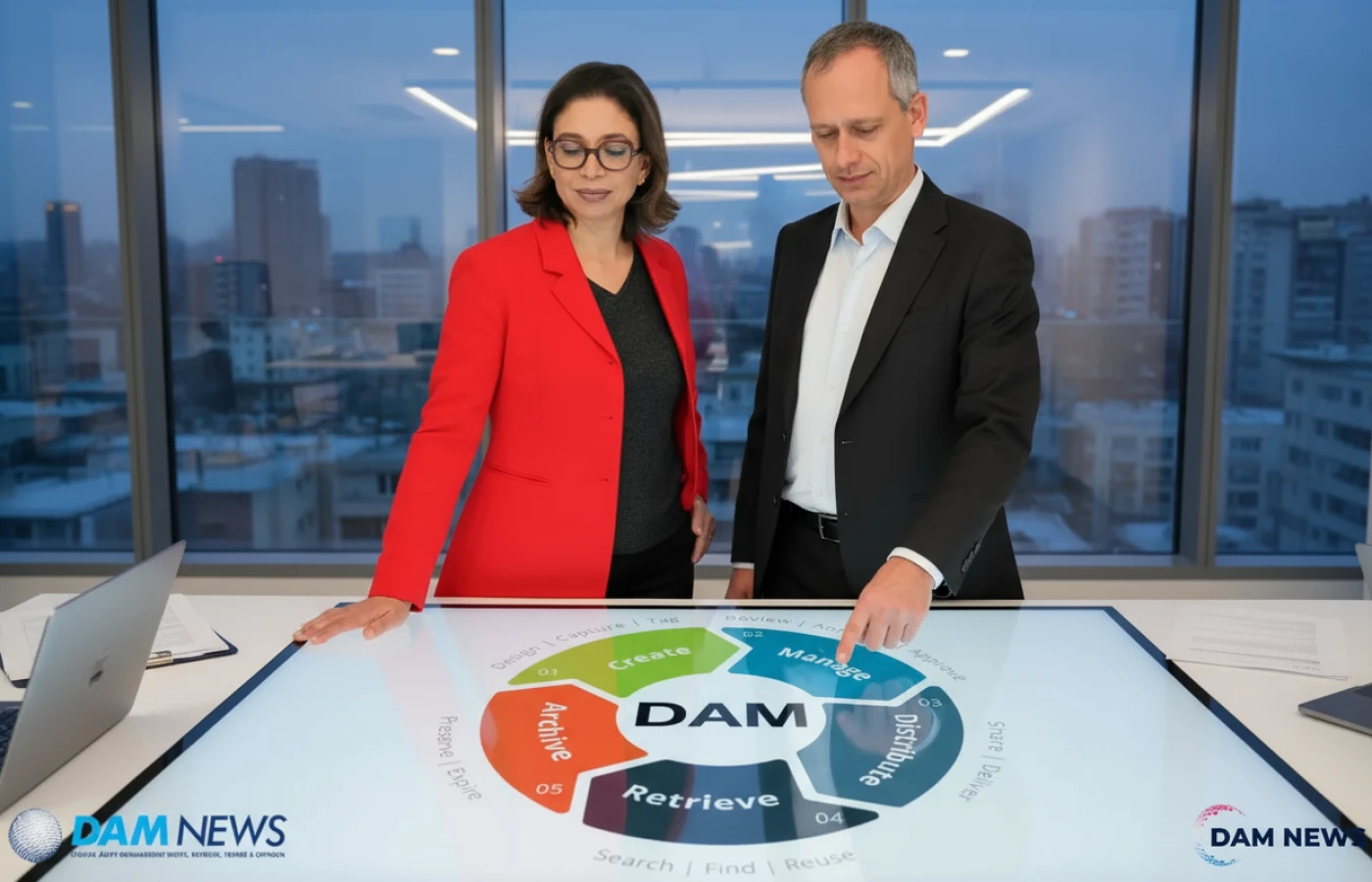
After approval, assets need to be distributed or published. A DAM solution integrates with downstream systems to facilitate this. For instance, when a product image is approved, the DAM can send the file and associated metadata to a CMS, where it appears on product pages. When a social media campaign is scheduled, the DAM can provide the proper versions of the images and videos to a publishing tool. Integration with PIM systems ensures that product media is synchronized with product information for e-commerce platforms. Integration with marketing automation tools allows email campaigns to pull in updated visuals automatically.
DAM platforms often provide portals or share links that enable external partners, agencies or clients to access curated collections of assets. These portals can be customized with branding and permissions to allow controlled access. They reduce the need for FTP uploads or emailing large files and ensure that external parties always have the latest, approved assets.
Tracking the usage of digital assets helps organizations understand how their content is performing and whether their investments yield returns. A DAM solution records how often assets are viewed, downloaded or shared, who accesses them and in what context. Reports might highlight the top assets for a campaign, identify underutilized assets or reveal which formats are most popular. Usage analytics can inform content strategy—showing which types of visuals resonate with audiences and guiding future content creation.
Reporting features also assist in rights management and compliance. For example, if a licensed photo’s usage period is about to expire, the DAM can alert the legal team and prevent further downloads. Audit logs track user activity, ensuring accountability and supporting data protection regulations.
Not all assets remain in active use indefinitely. When campaigns end or products are discontinued, assets may need to be retired or archived. A DAM solution automates archiving based on predetermined retention policies. It can move older versions to cold storage, maintain a historical record for reference or delete files when they are no longer needed. Archiving ensures that the active library stays relevant and reduces clutter while maintaining compliance and preserving organizational history.
Modern DAM solutions are not standalone systems; they form part of a larger content ecosystem. Integration is therefore a core function. Through APIs and connectors, a DAM can link to CMS platforms like WordPress, Drupal, Sitecore and Magento; PIM systems such as Akeneo, Plytix and Salsify; marketing automation tools like Marketo and HubSpot; social media management tools such as Hootsuite and Sprout Social; CRM systems like Salesforce; and project management tools like Monday.com and Asana. Integration reduces manual data entry, ensures metadata consistency and accelerates content delivery.
Additionally, some DAM platforms provide software development kits (SDKs) or open-source frameworks that allow organizations to build custom applications on top of the DAM. For example, a retail brand might develop an app that allows in-store staff to browse and download promotional materials, or a media company might create a portal that automatically generates streaming playlists from video assets stored in the DAM.
In conclusion, a DAM solution manages digital assets throughout their lifecycle—ingesting files, applying metadata, facilitating collaboration, publishing approved assets, tracking usage and archiving content. By automating and optimizing these processes, a DAM enables organizations to derive maximum value from their digital assets.
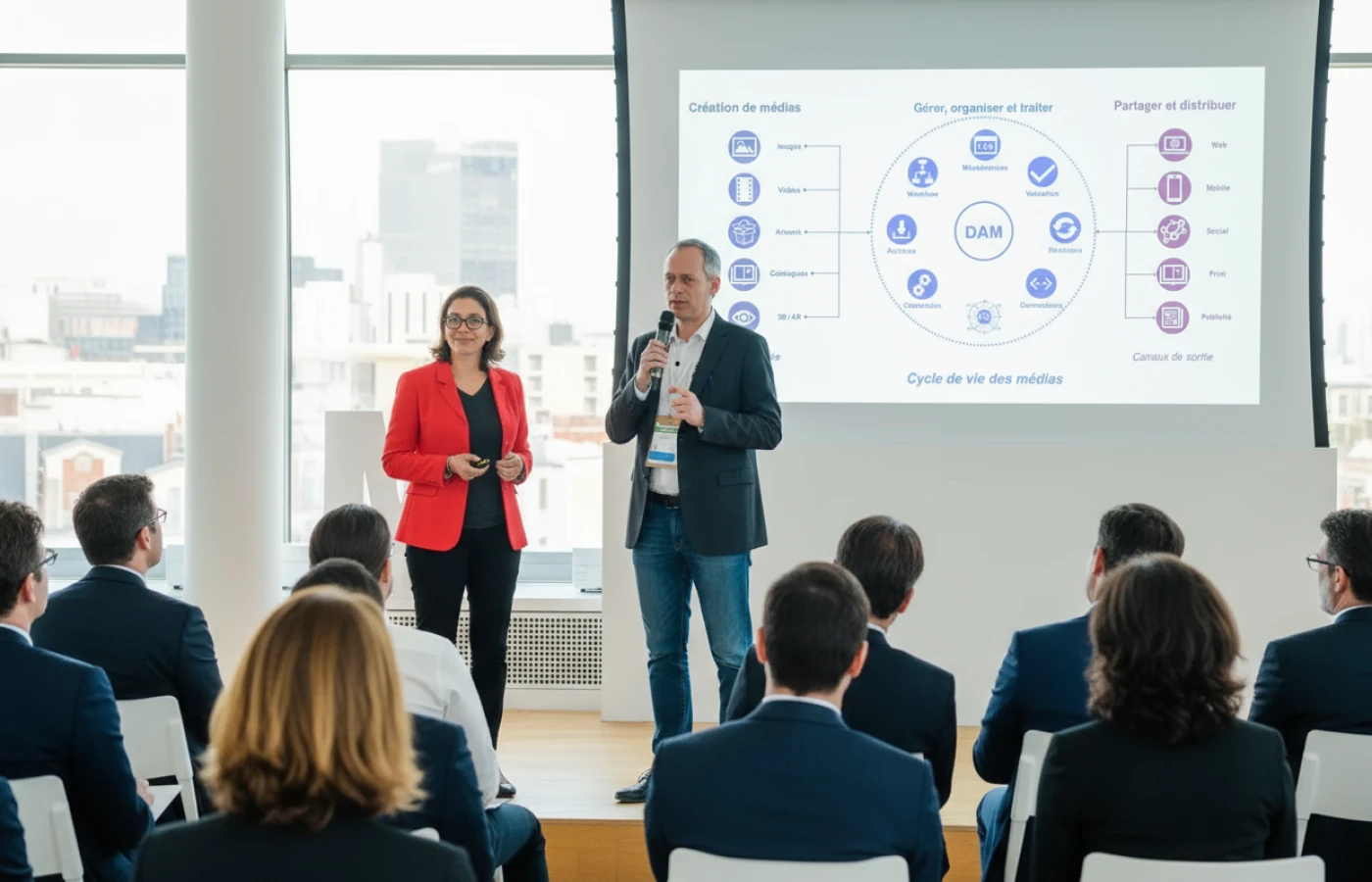
Implementing a digital asset management system yields a range of benefits that extend across the organization. These benefits can be categorized into efficiency, productivity, collaboration, security, brand consistency, compliance and strategic impact. Below we explore each category in depth.
One of the most immediate benefits of a DAM is the increased efficiency in finding and using assets. With a centralized repository and advanced search capabilities, users spend less time hunting for files and more time creating and strategizing. A DAM allows users to quickly locate a specific asset by typing in keywords, filtering by file type or selecting tags. Batch editing and automated metadata tagging further reduce time spent on manual tasks.
Increased efficiency also translates into higher productivity. When assets are easy to find and workflows are automated, projects move forward faster. Designers can access the exact assets they need without repeatedly requesting them from others. Marketing teams can quickly assemble campaign materials, sales teams can pull up-to-date collateral for presentations, and product teams can coordinate launches without delays.
Collaboration is central to content creation and marketing. A DAM enhances collaboration by providing a unified platform where all stakeholders can review and comment on assets. It eliminates version confusion by tracking changes and maintaining a single source of truth. Comments, annotations and feedback are centralized, avoiding lengthy email chains and miscommunications.
With clearly defined user roles and permissions, teams can collaborate securely, knowing that sensitive assets are protected. Designers, copywriters, brand managers, legal teams and external agencies can access the specific files they need while respecting approval processes and usage rights. This collaborative environment fosters teamwork and aligns everyone with the same goals.
A strong brand relies on consistency in visuals, messaging and tone. A DAM plays a crucial role in maintaining brand integrity by ensuring that approved assets are used across all channels. It stores logos, templates, brand guidelines, fonts and color palettes, making them easily accessible to anyone who needs them. When an update occurs—such as a logo redesign or a new color scheme—the DAM ensures that only the latest versions are available for download.
Templates stored in the DAM can enforce brand standards by providing pre-approved layouts and design elements. Marketing teams can create materials without deviating from guidelines, ensuring that every piece of communication reinforces the brand identity. Inconsistent branding can confuse customers and weaken brand perception, but with a DAM, organizations can present a unified look and feel across all touchpoints.
Digital assets are often subject to usage rights, licensing agreements and legal restrictions. A DAM helps organizations manage these complexities by tracking rights metadata, setting expiration dates and controlling access. For example, a stock photo may be licensed for a specific campaign and region; the DAM can track that license, prevent usage beyond its terms and notify stakeholders before it expires.
Compliance extends beyond licensing. Many industries face regulations related to data privacy, content accessibility, copyright and content retention. A DAM ensures that assets are stored and used in compliance with relevant laws and corporate policies. Audit trails record who accessed or modified an asset and when, providing transparency and accountability.

Digital assets can include sensitive information, proprietary designs, confidential documents and intellectual property. A DAM safeguards these assets through encryption, secure login procedures, multi-factor authentication and role-based permissions. Administrators can define who can view, edit or download specific files, ensuring that only authorized personnel have access.
The DAM also protects against data loss by storing assets on redundant servers or in the cloud with regular backups. If a local device fails, assets remain safe and accessible. By centralizing assets, organizations reduce the risk of unauthorized copies circulating on personal drives or third-party storage.
A DAM provides insights into how assets are used, enabling organizations to maximize their content investments. Tracking which assets are frequently downloaded, shared or incorporated into campaigns helps identify what works and what doesn’t. Underutilized assets can be repurposed, updated or retired. Highly successful assets can be analyzed to inform future content creation.
By tracking asset usage, organizations can also estimate the return on investment (ROI) of content production. For example, if a product video drives significant engagement on social media, it may warrant similar videos in future campaigns. Conversely, if an expensive photoshoot yields assets that are rarely used, the organization might reconsider its approach.
For global organizations, distributing assets across multiple markets and languages can be challenging. A DAM simplifies this by allowing users from different regions to access localized versions of assets. Language-specific metadata and region-based permissions ensure that the correct files are available to the right audience. Integration with translation tools can streamline the localization process by coordinating translations of metadata and content.
Today’s marketing strategies require cohesive content delivery across websites, email campaigns, social media, mobile apps, streaming platforms and print media. A DAM enables omnichannel marketing by integrating with content management systems, email marketing tools, social media management platforms and e-commerce systems. It ensures that the same approved assets appear consistently across channels, enabling a seamless customer experience.
A well-implemented DAM provides a foundation for future growth. As organizations produce more assets and adopt new technologies—such as augmented reality, virtual reality or 3D product visualization—a DAM can scale to accommodate these formats. Cloud-based DAMs allow organizations to expand storage and user capacity without significant infrastructure investment. Additionally, DAM vendors continuously innovate by incorporating AI, machine learning and advanced analytics, ensuring that the platform remains relevant in an evolving digital landscape.
In sum, the benefits of digital asset management extend far beyond file storage. A DAM enhances organizational efficiency, empowers collaboration, protects intellectual property, ensures brand consistency and delivers insights that inform strategic decisions. For any organization that creates or uses digital content, investing in a DAM can yield significant returns in productivity, cost savings and brand value.
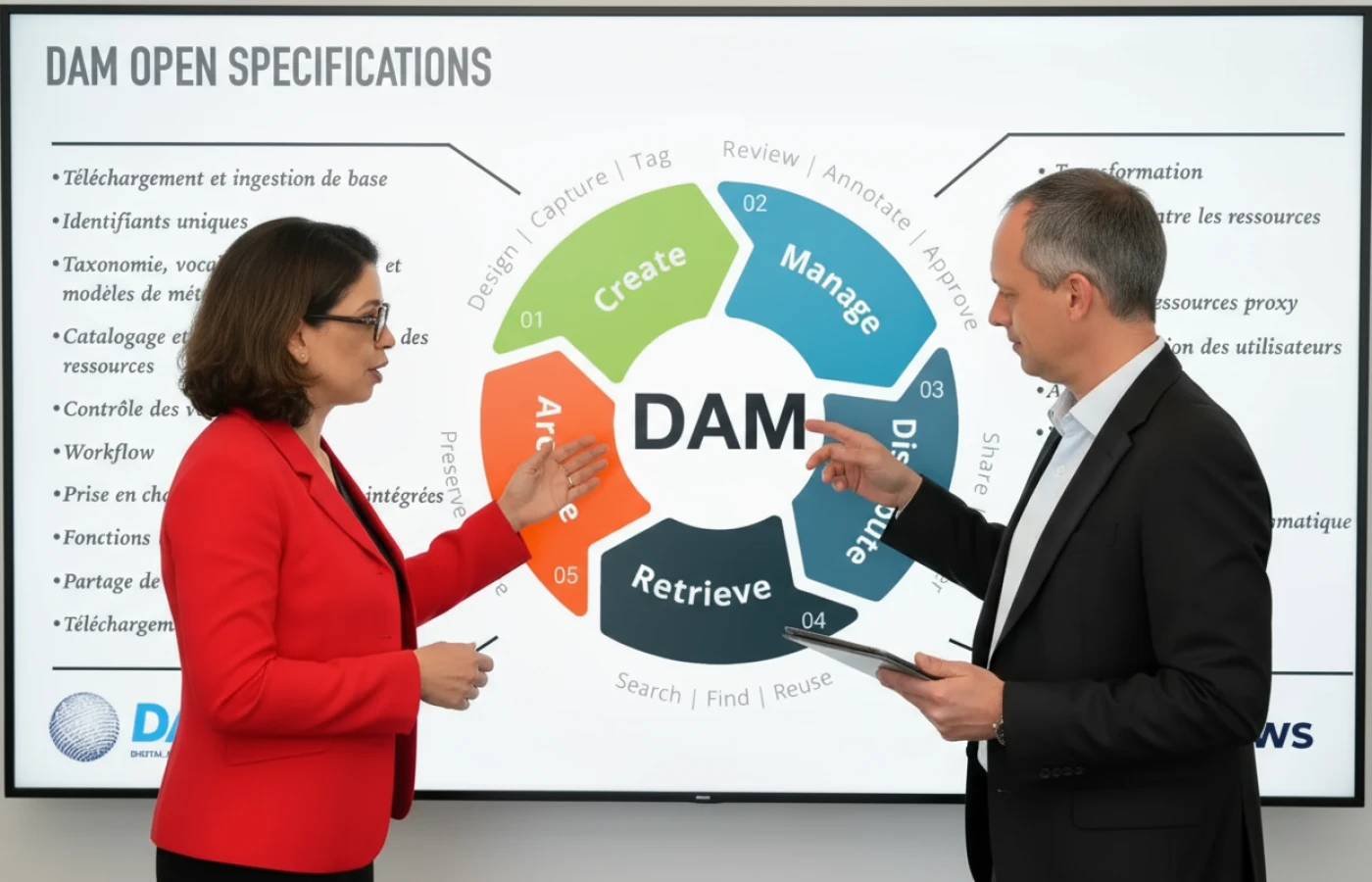
Digital asset management systems are used by a diverse range of individuals and departments within an organization. Because digital assets serve multiple purposes—from marketing and branding to training and technical documentation—a DAM becomes a central resource for many user groups. Here we highlight some of the key roles and teams that rely on DAM solutions.
Marketing and sales departments are often the primary users of a DAM. Marketers produce campaigns that include images, videos, banners, social media posts, landing pages and presentations. A DAM centralizes these materials, making it easy for marketers to find, repurpose and distribute content. Brand managers use the DAM to enforce consistency by storing brand guidelines, logos and templates.
Sales teams benefit from quick access to up-to-date collateral such as brochures, case studies and presentations. They can pull customized assets for specific clients or industries, ensuring that their messaging and visuals align with the latest campaigns. Additionally, marketing and sales teams can use analytics from the DAM to measure asset performance and optimize campaigns.
Designers, photographers, videographers and other creative professionals depend on the DAM to organize their work and collaborate with colleagues. They use the DAM to store high-resolution source files, share drafts, receive feedback and manage revisions. Creative teams can apply metadata to categorize assets by project, medium or client, making it easier to locate files.
By integrating with creative software like Adobe Creative Cloud, a DAM streamlines the workflow from creation to approval. Designers can save files directly into the DAM, ensuring that the latest versions are always accessible. They can also search the DAM for existing assets to avoid reinventing the wheel and to maintain continuity across projects.
For product-focused organizations, product management and e-commerce teams use DAM solutions to manage product images, videos, manuals, spec sheets and packaging designs. A DAM ensures that the correct product media is available for e-commerce platforms, catalogs and marketing materials. Integration with product information management systems synchronizes media with product data, ensuring accuracy and consistency across channels.
Product managers may also use the DAM to coordinate launches, store assets related to product development and track version histories of packaging and technical documents. By centralizing these assets, teams can quickly update product information across all touchpoints when specifications change.
Developers and IT professionals use DAMs to store code snippets, software builds, interface designs, system diagrams and documentation. A DAM helps manage these resources, especially when multiple teams collaborate on software projects. For example, developers working on a website or app may use the DAM to access design assets, icons, brand guidelines and technical documents.
IT departments often administer the DAM itself, configuring user roles, managing integrations and ensuring data security. They may also leverage APIs provided by the DAM to build custom applications or integrate with other systems, such as single sign-on services or content delivery networks.
Legal teams use digital asset management systems to organize contracts, license agreements, legal briefs, compliance documents and intellectual property records. By storing these documents in the DAM, legal teams ensure secure access, track version histories and manage rights and licensing. A DAM can alert legal teams when licenses are expiring or when assets are approaching usage limits, helping prevent compliance violations.
Compliance teams may also use the DAM to ensure that content adheres to regulatory requirements, particularly in regulated industries such as healthcare, finance and pharmaceuticals. They can review and approve assets, verify that required disclosures are included, and maintain an audit trail of approvals.
Human resources (HR) teams rely on digital assets for recruitment, onboarding and training. Videos and presentations about company culture, benefits, policies and job training materials are stored in the DAM. HR teams can share these assets with new hires, track which materials have been viewed and update content as policies change.
Training teams use the DAM to manage e-learning modules, instructional videos, course materials and certifications. By centralizing training resources, organizations ensure that employees always access the correct content and that training is consistent across locations.
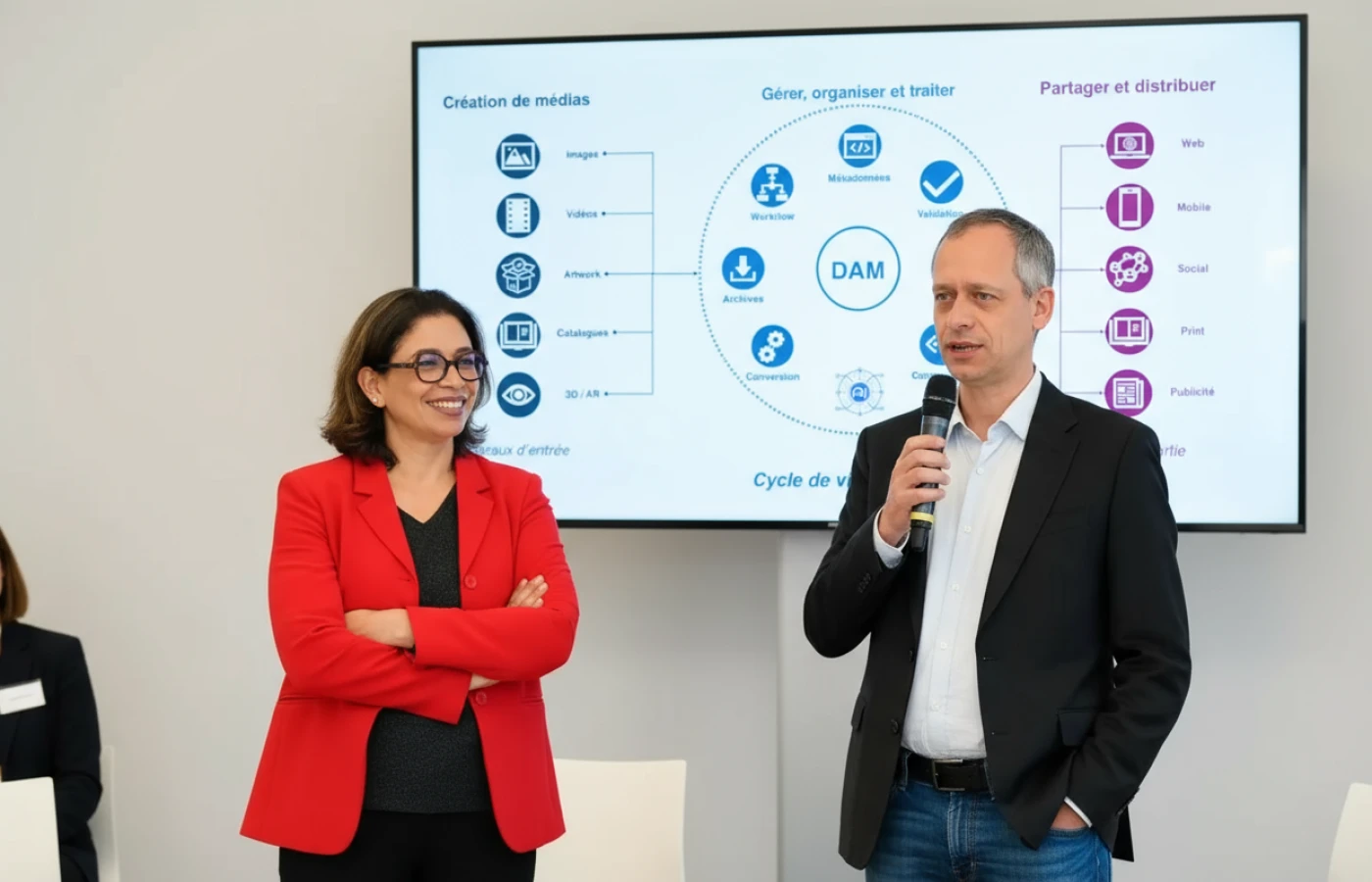
Organizations frequently collaborate with external agencies—such as advertising firms, design studios, public relations companies, translators and localization vendors. A DAM facilitates secure collaboration by allowing external users to access specific collections, upload drafts and receive feedback. Permissions can limit their access to relevant projects, protecting sensitive internal assets.
For multilingual or multinational campaigns, translators and localization partners can retrieve content from the DAM, translate or adapt it and upload localized versions. This seamless collaboration accelerates go-to-market timelines and ensures that assets remain consistent across languages and regions.
While executives may not interact with the DAM daily, they rely on it for strategic insights. Reports and analytics from the DAM reveal how content is used, which campaigns are most effective and where content investments yield the highest returns. Executives use this data to allocate budgets, make content strategy decisions and measure the ROI of creative efforts.
Some organizations extend DAM access to customers or user communities through branded portals. For example, a technology company might provide a portal with product images, logos and marketing materials for its resellers. A tourism board could share high-quality photos and videos with journalists, travel agencies and event organizers. These portals ensure brand consistency while empowering partners to promote products or destinations effectively.
In summary, a digital asset management system serves a wide range of users within and outside an organization. It provides a collaborative environment where marketing, design, product, legal, HR, IT and executive teams can access and leverage digital assets efficiently and securely. Recognizing the diverse user base helps organizations tailor their DAM implementation to meet varied needs and maximize adoption.
Digital asset management is applicable across nearly every industry. The following examples illustrate how different sectors leverage DAM to address their unique challenges and opportunities.
Retailers and e-commerce companies handle extensive catalogs of product images, videos, descriptions and marketing materials. A DAM ensures that these assets are organized by product SKU, category, season or campaign. Integration with PIM systems and e-commerce platforms ensures that product media and metadata are synchronized across websites, mobile apps and marketplaces. Retailers can quickly update images, launch seasonal campaigns and tailor content for different regions.
Media companies produce vast amounts of video footage, audio recordings, images and editorial content. A DAM enables broadcasters, film studios, news organizations and streaming services to store raw footage, edit sequences, manage rights and distribute content to various outlets. Version control and metadata ensure that editors and producers find the right clips quickly. For live events, a DAM supports rapid publishing to multiple channels.
Manufacturers create engineering drawings, 3D models, product manuals, safety instructions and marketing materials. A DAM centralizes these assets, ensuring that teams across product design, production, marketing and sales have access to the correct versions. Integrating the DAM with PLM (Product Lifecycle Management) and PIM systems keeps product data synchronized. Manufacturing companies also use DAMs to store training videos for assembly and maintenance.
Healthcare providers and life science companies deal with sensitive content, including medical images, research reports, patient education materials and regulatory documents. A DAM provides secure storage, access control and auditing to ensure compliance with health privacy laws and industry regulations. Researchers can share clinical trial data, while marketing teams can manage educational content and branding for pharmaceutical products.
Educational institutions create and manage lecture videos, course materials, research publications, promotional content and alumni communications. A DAM supports e-learning by storing lectures and learning resources, enabling access for students, faculty and staff. It also helps universities and schools manage their brand identity, centralize marketing assets and share content with prospective students and donors.
Non-profits rely on storytelling to engage donors, volunteers and beneficiaries. They accumulate event photos, campaign videos, donor outreach materials and impact reports. A DAM helps centralize these assets, enabling teams to quickly assemble fundraising campaigns, social media posts and grant proposals. Secure access ensures that sensitive information about beneficiaries is protected, while portals enable collaboration with partner organizations.
Government agencies produce public service announcements, policy documents, training materials and multimedia resources. A DAM ensures that official logos, documents and communications adhere to guidelines and are accessible to authorized staff. It supports transparency by providing access to public records while protecting sensitive information through role-based permissions. For emergency services, a DAM facilitates rapid distribution of vital information.
Hotels, airlines and tourism boards use visual content to attract travelers. They manage high-resolution photos and videos of destinations, properties, events and packages. A DAM organizes these assets by location, property, event or seasonal promotion, enabling marketing teams to create enticing campaigns quickly. Integration with booking systems and third-party travel sites ensures that content is consistent and up to date.
Technology companies create product screenshots, app videos, UI mockups, technical documentation, user guides and training materials. A DAM centralizes these assets, ensuring that product launches and updates are accompanied by accurate, branded content. Technical documentation can be versioned and updated as software evolves. Localization and translation workflows help adapt content for global markets.
These use cases demonstrate that digital asset management is not confined to a single industry; rather, it is a versatile solution that addresses common challenges across sectors. By tailoring metadata, workflows and integrations to their specific needs, organizations from diverse industries can optimize their content lifecycle and improve their efficiency.
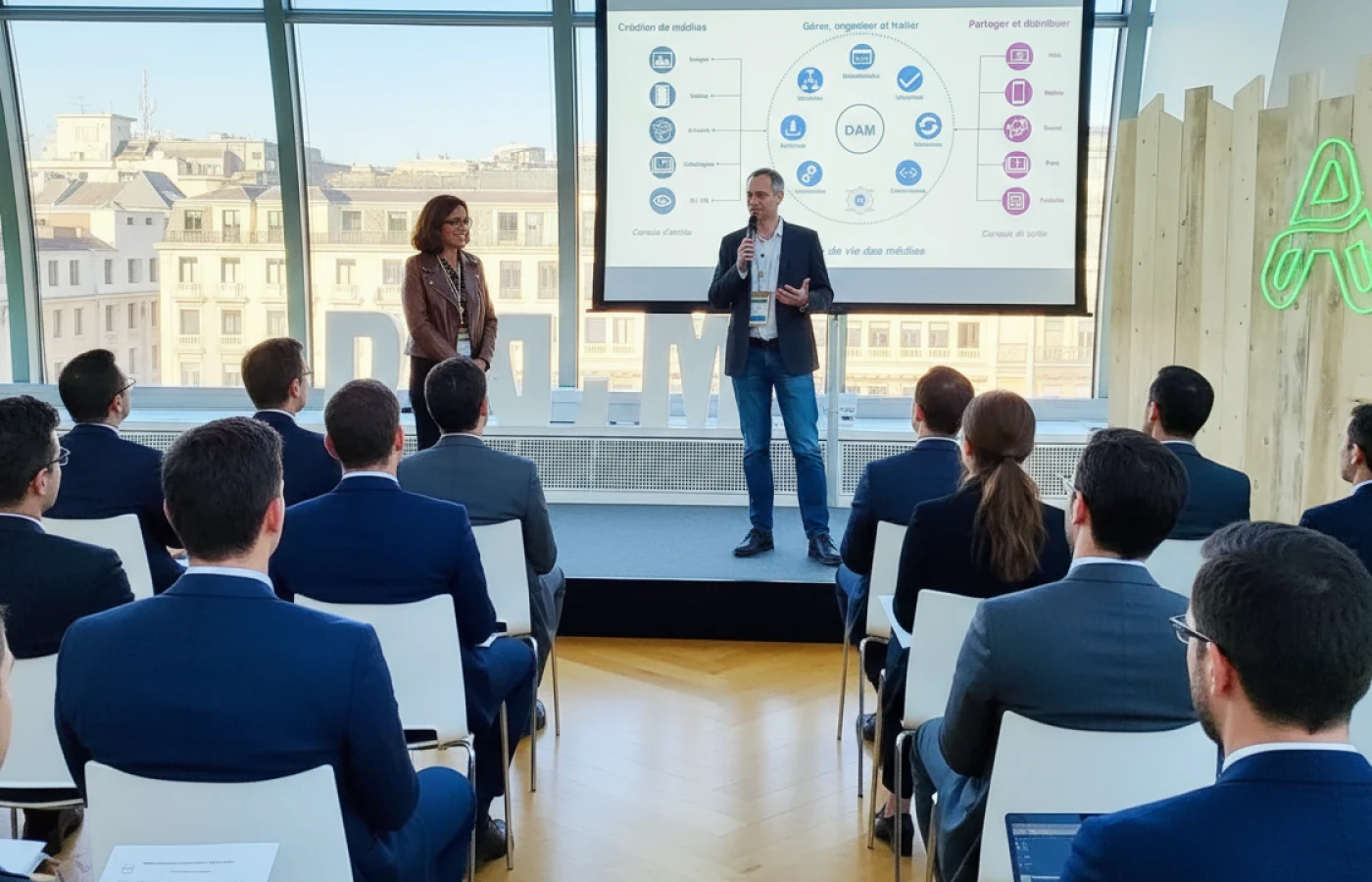
Selecting the most suitable DAM solution involves evaluating your organization’s needs, capabilities and long-term objectives. Here is a step-by-step approach to choosing a DAM platform that aligns with your goals.
Begin by defining why your organization needs a DAM. Are you aiming to improve brand consistency, accelerate content production, manage product media, support global teams or ensure compliance? Identify the stakeholders who will use the system—marketing, design, sales, legal, IT—and gather their requirements. Understanding the problems you aim to solve and the needs of different teams will guide your evaluation.
Conduct a thorough audit of how your organization currently manages digital assets. Identify where assets are stored, how they are organized, how approvals are managed and where bottlenecks occur. Determine which tools you already use (CMS, PIM, project management, design software) and how they might integrate with a DAM. This audit will reveal the gaps that a DAM needs to fill and the integrations required.
Based on your objectives and audit, list the features that are critical for your DAM. Consider:
Distinguish between essential features and nice-to-have features. This will help narrow down the list of vendors and ensure that you do not overpay for unnecessary functionalities.
Research vendors that offer DAM platforms aligned with your feature requirements. Request demos, participate in webinars, and explore trial versions. Pay attention to user experience: is the interface intuitive? Is it easy to upload, tag and search for assets? How quickly can new users become proficient?
Ask vendors about their implementation process, training and support. A successful DAM rollout depends on adequate guidance and resources. Inquire about uptime guarantees, maintenance schedules and customer references. Evaluate the vendor’s reputation, track record, and financial stability to ensure they will be a long-term partner.
Integration with existing systems is a critical factor. Evaluate how well each DAM integrates with your CMS, PIM, CRM, marketing automation tools, design software and project management platforms. Look for pre-built connectors or robust APIs. Strong integration reduces manual effort, increases adoption and ensures seamless workflows.
Consider any future systems your organization might adopt. Will the DAM support additional integrations as your technology stack evolves? A flexible and open architecture ensures that the DAM remains relevant even as your tools change.
Decide whether you prefer a cloud-based or on-premises deployment. Cloud-based DAMs offer scalability, automatic updates and reduced infrastructure management. On-premises solutions provide more control over data storage and may satisfy stringent security requirements. Hybrid models combine both, allowing sensitive data to reside on-prem while leveraging cloud capabilities for certain workflows.
Assess the scalability of each solution. Can the DAM handle increasing volumes of assets, users and metadata? Does it support large file sizes, including 4K videos or 3D models? Scalability ensures that your investment continues to deliver value as your organization grows.
DAM pricing varies widely based on features, storage, users and support. Some vendors charge per user, others per storage volume, and some combine both. Compare the total cost of ownership, including setup fees, training, maintenance, support and potential upgrade costs. Consider your budget and align it with the ROI you expect from the DAM.
While cost is important, it should not be the sole deciding factor. A slightly more expensive solution that meets all your requirements and ensures user adoption may deliver greater long-term value than a cheaper alternative that lacks critical features or support.
Once you select a DAM, plan your implementation carefully. Define a metadata strategy and taxonomy that align with your business structure and user needs. Migrate existing assets into the DAM, ensuring that metadata is applied consistently. Train users across departments to ensure they understand how to upload, find, share and approve assets. Establish governance policies, including who is responsible for managing the system, who can approve assets and how new metadata fields are added.
Change management is essential to drive adoption. Communicate the benefits of the DAM, demonstrate how it addresses current pain points, and provide ongoing training. Encourage feedback from users and refine processes as needed. A well-executed implementation will maximize user engagement and deliver the intended benefits.
After deployment, track usage metrics, monitor performance and gather feedback from users. Evaluate whether the DAM is improving asset retrieval times, reducing duplicate requests, enhancing collaboration and supporting brand consistency. Use analytics to identify which features are used most frequently and which may need refinement. Iterate on metadata taxonomy, workflows and user permissions as your organization evolves.
By continuously measuring success, you can make adjustments to maximize the value of your DAM investment and demonstrate its ROI to stakeholders.

Implementing a DAM involves more than installing software; it requires careful planning, alignment with business processes and ongoing maintenance. The following best practices can help ensure a successful implementation.
A clear metadata strategy is foundational to effective digital asset management. Define a schema that includes the fields needed to describe your assets (e.g., title, description, keywords, campaign, product, usage rights, creator, date). Establish controlled vocabularies and taxonomies to ensure consistency. Decide which metadata is mandatory and provide guidelines on how to enter it. Regularly review and update the metadata strategy to reflect evolving needs.
Include representatives from all relevant departments—marketing, creative, sales, IT, legal, HR—in the planning process. Gather their input on workflows, permission levels, metadata fields and integration needs. Involving stakeholders early fosters buy-in, ensures the DAM addresses real needs and helps identify potential challenges.
When rolling out the DAM, consider starting with a pilot project or a single department. This allows you to test workflows, refine metadata and gather feedback without overwhelming the entire organization. Once the system is stable and successful in the pilot group, gradually expand to other departments or regions. A phased approach reduces risk and encourages adoption.
Training is critical for adoption. Offer hands-on sessions, tutorials, documentation and videos that cover basic usage, metadata entry, search techniques and approval workflows. Tailor training to different roles; for example, creatives may need to know how to upload and tag assets, while managers need to understand approval processes and analytics. Provide ongoing training and support as new features are added or new users join.
Set up governance to define how the DAM is managed. Assign responsibility for metadata maintenance, user administration, workflow management and system updates. Establish policies for naming conventions, folder structures, versioning, rights management, and archiving. Governance ensures consistency, prevents misuse and keeps the system organized.
Regularly review metadata and asset organization to maintain data quality. Identify and resolve issues like missing metadata, duplicate assets or outdated files. Clean up unused assets and archive or delete outdated versions. Keeping the DAM tidy improves user experience and search efficiency.
Solicit feedback from users on the DAM’s performance, usability and any obstacles they encounter. Use this feedback to make improvements, whether adjusting metadata, tweaking workflows or enhancing training materials. Continuous improvement ensures the DAM remains aligned with evolving business needs and user expectations.
Digital asset management is evolving rapidly as technology advances and business needs change. Several trends are shaping the future of DAM:
AI is enhancing DAM capabilities in tagging, search, content generation and analytics. Image recognition and natural language processing automate metadata tagging, reducing manual effort and increasing accuracy. AI can suggest relevant assets for campaigns, detect duplicate images, predict content performance and generate alt text for accessibility. Machine learning algorithms analyze usage patterns to recommend assets or content strategies, improving efficiency and personalization.
The rise of headless CMS and composable architectures is influencing DAM systems. Headless DAM separates the backend asset repository from the presentation layer, allowing assets to be delivered via APIs to any front-end application, whether a website, mobile app, AR/VR experience or IoT device. This flexibility supports omnichannel content delivery and integrates the DAM into a composable digital experience platform.
As content ecosystems become more complex, closer integration between DAM, PIM and CMS systems is essential. Businesses require seamless synchronization of product data, media assets and content across channels. Integration ensures that product images, videos and documents are linked to product information and are automatically updated across e-commerce sites, catalogs and marketing campaigns.
With increasing data breaches and stricter privacy regulations, DAM vendors are enhancing security features. Advanced encryption, zero-trust architectures, user behavior analytics and automated compliance checks will become standard. Organizations will demand greater control over where and how their assets are stored, including data residency options and compliance with regional laws.
Usability remains a priority. Vendors are focusing on intuitive interfaces, personalized dashboards and improved mobile experiences. As DAMs cater to a broader range of users, from creative professionals to business executives, the user experience will be tailored to each role. Personalized recommendations, custom workflows and role-based dashboards will enhance adoption and satisfaction.
With growing awareness of environmental impact, organizations are evaluating the carbon footprint of their digital operations. Cloud providers are investing in sustainable infrastructure, and DAM vendors will emphasize green cloud hosting, energy-efficient data centers and tools to help organizations track and reduce the environmental impact of storing and delivering digital assets.
Analytics capabilities will expand from basic usage reporting to predictive insights. DAM systems will provide deeper analysis of asset performance, audience engagement and content ROI. Integration with business intelligence tools will allow organizations to correlate asset usage with sales, conversions and customer behavior. These insights will inform content strategy, budgeting and campaign planning.
Automation will extend to content creation and dynamic asset generation. Templates and AI-driven tools will allow marketers to generate personalized versions of assets on the fly, adapting images, text and layouts for different audiences, devices and channels. This enables large-scale personalization without manual intervention and ensures brand consistency across personalized experiences.
The future of digital asset management promises greater intelligence, flexibility, integration and user-centric design. As organizations continue to embrace digital transformation, investing in a DAM that evolves with these trends will be key to maintaining a competitive edge.
Digital asset management has become an indispensable practice for organizations that produce, store and distribute digital content. From high-resolution images and videos to design files, documents, audio recordings and code, digital assets represent the creative and operational lifeblood of modern businesses. Without a structured system, these assets become scattered, underutilized or misused, leading to inefficiencies, inconsistent branding and compliance risks.
A digital asset management system centralizes and organizes assets, applies rich metadata, enables advanced search, tracks versions, controls access, automates workflows and integrates with other systems. The benefits of implementing a DAM are far-reaching: increased efficiency, productivity and collaboration; consistent brand identity; stronger rights management and compliance; enhanced security; better utilization of assets and improved ROI.
DAM is not limited to marketing departments—it serves designers, product managers, sales teams, IT professionals, legal teams, HR and external partners. Industries from retail and media to healthcare, education and government leverage DAM to solve unique challenges. Choosing the right DAM requires careful assessment of needs, evaluation of features and vendors, and thoughtful planning for implementation and change management.
As technology advances, digital asset management continues to evolve. Artificial intelligence, headless architectures, deeper integration with PIM and CMS, enhanced security, sustainability and advanced analytics are shaping the future of DAM. Organizations that invest in a scalable, adaptable DAM and adopt best practices will position themselves to leverage their digital assets effectively, delivering consistent, personalized experiences across channels and maintaining a competitive advantage in the digital marketplace.